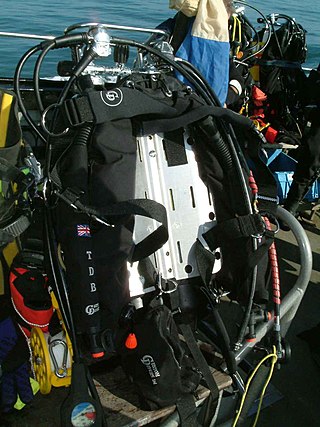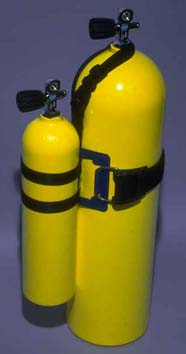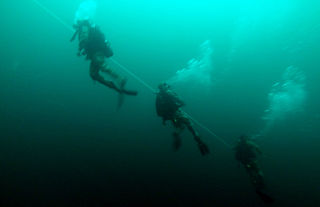Related Research Articles

A scuba set, originally just scuba, is any breathing apparatus that is entirely carried by an underwater diver and provides the diver with breathing gas at the ambient pressure. Scuba is an anacronym for self-contained underwater breathing apparatus. Although strictly speaking the scuba set is only the diving equipment that is required for providing breathing gas to the diver, general usage includes the harness or rigging by which it is carried and those accessories which are integral parts of the harness and breathing apparatus assembly, such as a jacket or wing style buoyancy compensator and instruments mounted in a combined housing with the pressure gauge. In the looser sense, scuba set has been used to refer to all the diving equipment used by the scuba diver, though this would more commonly and accurately be termed scuba equipment or scuba gear. Scuba is overwhelmingly the most common underwater breathing system used by recreational divers and is also used in professional diving when it provides advantages, usually of mobility and range, over surface-supplied diving systems and is allowed by the relevant legislation and code of practice.
The timeline of underwater diving technology is a chronological list of notable events in the history of the development of underwater diving equipment. With the partial exception of breath-hold diving, the development of underwater diving capacity, scope, and popularity, has been closely linked to available technology, and the physiological constraints of the underwater environment.

A diving cylinder or diving gas cylinder is a gas cylinder used to store and transport high pressure gas used in diving operations. This may be breathing gas used with a scuba set, in which case the cylinder may also be referred to as a scuba cylinder, scuba tank or diving tank. When used for an emergency gas supply for surface supplied diving or scuba, it may be referred to as a bailout cylinder or bailout bottle. It may also be used for surface-supplied diving or as decompression gas. A diving cylinder may also be used to supply inflation gas for a dry suit or buoyancy compensator. Cylinders provide gas to the diver through the demand valve of a diving regulator or the breathing loop of a diving re-breather.

Recreational diver training is the process of developing knowledge and understanding of the basic principles, and the skills and procedures for the use of scuba equipment so that the diver is able to dive for recreational purposes with acceptable risk using the type of equipment and in similar conditions to those experienced during training.

A buoyancy compensator (BC), also called a buoyancy control device (BCD), stabilizer, stabilisor, stab jacket, wing or adjustable buoyancy life jacket (ABLJ), depending on design, is a type of diving equipment which is worn by divers to establish neutral buoyancy underwater and positive buoyancy at the surface, when needed.

The buddy check is a procedure carried out by scuba divers using the buddy system where each dive buddy checks that the other's diving equipment is configured and functioning correctly just before the start of the dive. A study of pre-dive equipment checks done by individual divers showed that divers often fail to recognize common equipment faults. By checking each other's equipment as well as their own, it is thought to be more likely that these faults will be identified prior to the start of the dive. The correct use of a well designed written checklist is known to be more reliable, and is more likely to be used by professional divers, where it may be required by occupational health and safety legislation, and by technical divers, where the equipment checks are more complex.

A backplate and wing is a type of scuba harness with an attached buoyancy compensation device (BCD) which can be used to establish neutral buoyancy underwater and positive buoyancy at the surface. Unlike most other BCDs, the backplate and wing is a modular system, in that it consists of separable components. The core components of this system are:

Scuba diving is a mode of underwater diving whereby divers use breathing equipment that is completely independent of a surface breathing gas supply, and therefore has a limited but variable endurance. The name scuba is an anacronym for "Self-Contained Underwater Breathing Apparatus" and was coined by Christian J. Lambertsen in a patent submitted in 1952. Scuba divers carry their own source of breathing gas, usually compressed air, affording them greater independence and movement than surface-supplied divers, and more time underwater than free divers. Although the use of compressed air is common, a gas blend with a higher oxygen content, known as enriched air or nitrox, has become popular due to the reduced nitrogen intake during long or repetitive dives. Also, breathing gas diluted with helium may be used to reduce the effects of nitrogen narcosis during deeper dives.

A pony bottle or pony cylinder is a small diving cylinder which is fitted with an independent regulator, and is usually carried by a scuba diver as an auxiliary scuba set. In an emergency, such as depletion of the diver's main air supply, it can be used as an alternative air source or bailout bottle to allow a normal ascent in place of a controlled emergency swimming ascent. The key attribute of a pony bottle is that it is a totally independent source of breathing gas for the diver.

The European Underwater Federation (EUF) is an umbrella organisation representing the interests of scuba diver training organisations operating in both the not for profit and for profit sectors within Europe.

A bailout bottle (BoB) or, more formally, bailout cylinder is a scuba cylinder carried by an underwater diver for use as an emergency supply of breathing gas in the event of a primary gas supply failure. A bailout cylinder may be carried by a scuba diver in addition to the primary scuba set, or by a surface supplied diver using either free-flow or demand systems. The bailout gas is not intended for use during the dive except in an emergency, and would be considered a fully redundant breathing gas supply if used correctly. The term may refer to just the cylinder, or the bailout set or emergency gas supply (EGS), which is the cylinder with the gas delivery system attached. The bailout set or bailout system is the combination of the emergency gas cylinder with the gas delivery system to the diver, which includes a diving regulator with either a demand valve, a bailout block, or a bailout valve (BOV).

Underwater breathing apparatus is equipment which allows the user to breathe underwater. The three major categories of ambient pressure underwater breathing apparatus are:
Fenzy is a scuba diving and industrial breathing equipment design and manufacturing firm. It started in or before 1920 in France. Finally Honeywell bought them out.

An emergency ascent is an ascent to the surface by a diver in an emergency. More specifically, it refers to any of several procedures for reaching the surface in the event of an out-of-gas emergency, generally while scuba diving.

Scuba skills are skills required to dive safely using self-contained underwater breathing apparatus, known as a scuba set. Most of these skills are relevant to both open-circuit scuba and rebreather scuba, and many also apply to surface-supplied diving. Some scuba skills, which are critical to divers' safety, may require more practice than standard recreational training provides to achieve reliable competence.

The history of scuba diving is closely linked with the history of the equipment. By the turn of the twentieth century, two basic architectures for underwater breathing apparatus had been pioneered; open-circuit surface supplied equipment where the diver's exhaled gas is vented directly into the water, and closed-circuit breathing apparatus where the diver's carbon dioxide is filtered from the exhaled breathing gas, which is then recirculated, and more gas added to replenish the oxygen content. Closed circuit equipment was more easily adapted to scuba in the absence of reliable, portable, and economical high pressure gas storage vessels. By the mid-twentieth century, high pressure cylinders were available and two systems for scuba had emerged: open-circuit scuba where the diver's exhaled breath is vented directly into the water, and closed-circuit scuba where the carbon dioxide is removed from the diver's exhaled breath which has oxygen added and is recirculated. Oxygen rebreathers are severely depth limited due to oxygen toxicity risk, which increases with depth, and the available systems for mixed gas rebreathers were fairly bulky and designed for use with diving helmets. The first commercially practical scuba rebreather was designed and built by the diving engineer Henry Fleuss in 1878, while working for Siebe Gorman in London. His self contained breathing apparatus consisted of a rubber mask connected to a breathing bag, with an estimated 50–60% oxygen supplied from a copper tank and carbon dioxide scrubbed by passing it through a bundle of rope yarn soaked in a solution of caustic potash. During the 1930s and all through World War II, the British, Italians and Germans developed and extensively used oxygen rebreathers to equip the first frogmen. In the U.S. Major Christian J. Lambertsen invented a free-swimming oxygen rebreather. In 1952 he patented a modification of his apparatus, this time named SCUBA, an acronym for "self-contained underwater breathing apparatus," which became the generic English word for autonomous breathing equipment for diving, and later for the activity using the equipment. After World War II, military frogmen continued to use rebreathers since they do not make bubbles which would give away the presence of the divers. The high percentage of oxygen used by these early rebreather systems limited the depth at which they could be used due to the risk of convulsions caused by acute oxygen toxicity.

The following outline is provided as an overview of and topical guide to underwater diving:
References
- ↑ "REVIEW: AP DIVING COMMANDO ESCAPE - DIVE Magazine". divemagazine.co.uk. Archived from the original on 2017-04-07.
- ↑ "Military BCDS & Commercial Dive Jackets from AP Diving". Archived from the original on 2017-07-11. Retrieved 2017-05-27.
- ↑ "Cardiff Scuba - TDI Rebreather Air Diluent (DECO - 45mt) - 5 Star IDC Scuba training in South Wales". www.cardiffscuba.co.uk. Archived from the original on 2014-05-28.
- ↑ Staff. "Key milestones in BSAC's history: 2001 - rebreather go-ahead". www.bsac.com. British Sub-Aqua Club. Retrieved 27 May 2017.[ permanent dead link ]
- ↑ Staff (21 November 2016). "Upcoming events". AP Diving. Archived from the original on 17 March 2017. Retrieved 30 May 2017.
- ↑ Staff. "Inspiration rebreathers". Dive Inspiration. AP Valves. Archived from the original on 11 July 2017. Retrieved 27 May 2017.
- ↑ Staff (5 April 2017). "Product announcement - Inspiration Classic Electronics - End of Product Life – April 2017". AP Diving News. AP Diving. Archived from the original on 28 May 2018. Retrieved 30 May 2017.
- ↑ "Diver October 2015".
- ↑ Staff. "The Commando: a jacket with a proud military history". Military and commercial. AP Diving. Archived from the original on 4 October 2024. Retrieved 27 May 2017.
- ↑ Staff. "The mark IV jump jacket". Military & commercial. AP Diving. Archived from the original on 11 July 2017. Retrieved 27 May 2017.
- ↑ Rosemary E Lunn: Martin Parker Receives EUF Lavanchy Award At Boot 2018 Archived 2018-04-10 at the Wayback Machine X-Ray Magazine